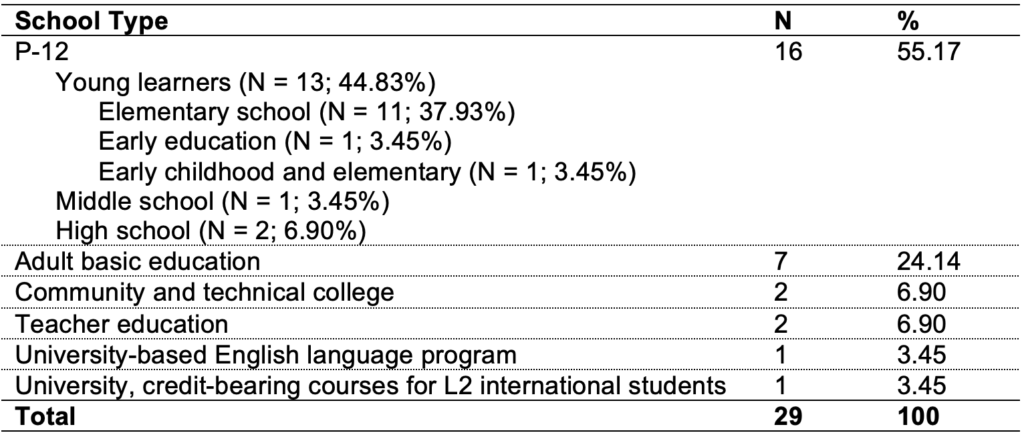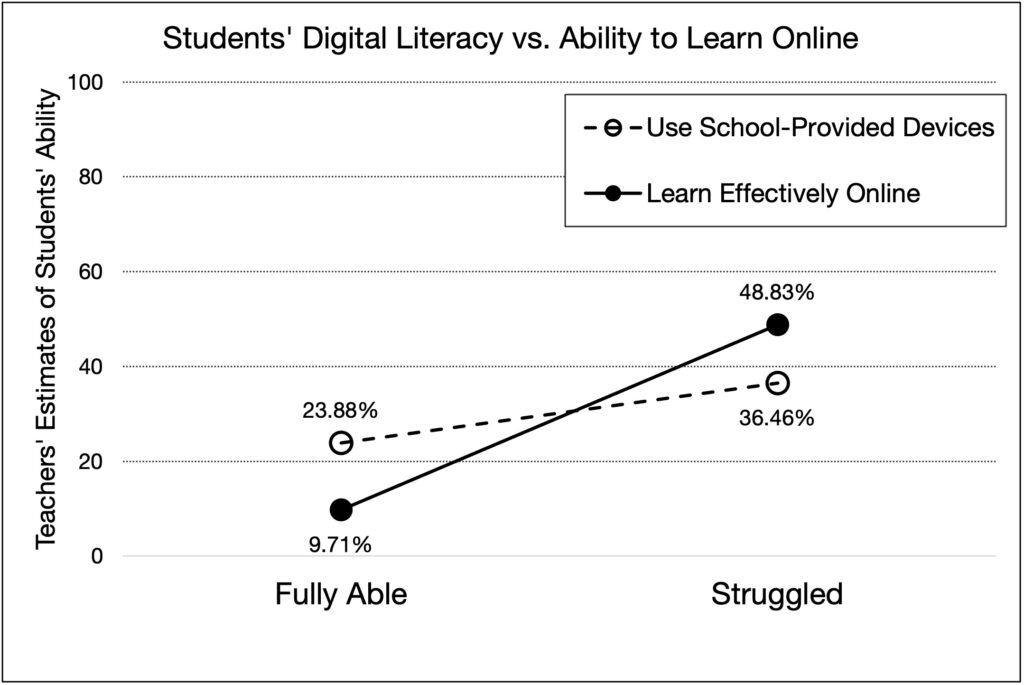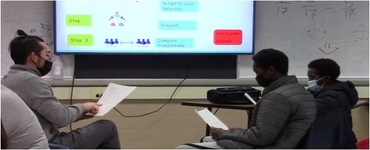A survey of the MinneTESOL membership shows that even early in the pandemic, teachers reported that distance learning negatively affected students’ acquisition of social and academic English.
Keywords: P–12 education, adult basic education, higher education, English learners, distance learning, pandemic, emergency remote teaching, academic English
In response to the COVID-19 pandemic, many schools moved to emergency remote instruction in early 2020. In a survey of Minnesota English as a Second Language (ESL) teachers about their experiences during the initial period of distance learning in March 2020, we found that teachers reported distance learning hindered students’ acquisition of social and academic English, especially students with lower proficiency, less class engagement, or fewer social supports. In addition, many students lacked access to the internet, or to the technology or skills they needed to succeed in distance learning. Teachers also reported lacking access to technology or skills and facing challenges communicating with students and students’ families. The gaps in technology access, skills, and communication help explain students’ learning loss. Our findings have implications for how schools support learners when remote learning might be necessary, such as when schools institute e-learning days in response to short term disruptions, such as inclement weather. Below, we explain the background of the study, report selected findings, and discuss recommendations.
Literature review
The COVID-19 pandemic is not the first to close Minnesota schools. For example, Minneapolis schools closed in response to the 1918 influenza pandemic (“Guilford wins fight to keep schools shut,”1918). Barry (2018) reported that the 1918 influenza pandemic led to school closures in many parts of the United States, for example in Philadelphia (p. 328) and Los Angeles (p. 336). In Spring 2020, Minnesota closed schools and moved students to distance learning; 79,361 of those students in grades K-12 (8.5% of the total) were English learners (Minnesota Department of Education, 2021). For context, just over 55 million U.S. students and globally about 1.26 billion students, in classes ranging from kindergarten to higher education (71.8% of all students in 117 countries), were similarly affected (Education Week, 2020; United Nations Educational, Scientific and Cultural Organization, 2022).
Minnesota distinguished distance learning from online teaching, requiring that distance learning be “equitably accessed by all students,” including access to their teachers and course content (Minnesota Department of Education, 2020, p. 3). Schools adapted existing digital resources to distance learning (Saint Paul Public Schools, 2020). Hodges et al. (2020) described the general shift to distance learning as “emergency remote teaching” (para. 5), contrasting it with purposely designed online teaching. As may be expected, the challenges were many as teachers and students navigated this new reality.
In April and May of 2020, MinneTESOL, the Minnesota affiliate of Teachers of English to Speakers of Other Languages International Association, surveyed English learner (EL) teachers about their experiences of and recommendations for “online teaching and learning” during distance learning (MinneTESOL, 2020). The majority of the 110 participants (50.9 percent; N=56) taught English learners in the elementary grades. Among their responses, EL teachers reported that they were supporting their students by contacting students and students’ families, by making “live videos,” and by collaborating with their students’ non-ESL teachers. Teachers reported challenges contacting students and their families, and reported that students and families faced challenges resulting from a lack of digital skills, a lack of access to technology or the internet or translation help or other resources, and challenges stemming from being overwhelmed.
Moser et al.’s (2021) participants similarly found teaching during the early pandemic to be a complex endeavor. In a survey of 377 language teachers in the United States, the researchers found that P–12 teachers and teachers with less online teaching experience worried more about students’ success during emergency remote learning. In addition, Moser et al. reported that ESL teachers were underrepresented in their study.
Outside of the United States, two case studies in Hong Kong (Cheung, 2021, 2023) highlight the highly context-dependent nature of success during emergency remote learning, specifically due to teachers’ pedagogical knowledge and beliefs. In both cases, Cheung considered English language teachers’ use of Zoom in response to the pandemic in 2020 and found that a high school teacher replicated a teacher-centered approach and failed to use Zoom’s affordances, while an elementary teacher used Zoom’s affordances to promote student interaction. In a survey- and interview-based study of boredom in online learning among 208 students in English programs (teaching English as a foreign language, translation, literature) across 24 higher education institutions in Iran, Derakhshana et al. (2021) found that their participants reported experiencing boredom in online classes caused by technical difficulties, too much teacher talk, and not enough interaction. The study also found that boredom increased by the end of the 90-minute class sessions. Recommendations included more interaction and improved digital literacy.
In summary, EL teachers and English learners, globally and in Minnesota, faced challenges moving to distance learning in response to the COVID-19 pandemic. Outside of the studies reviewed above, we found very little research on EL teachers’ experiences during distance learning. Because emergency remote teaching may occur in the future, there is a need to look more deeply into teachers’ experiences during the pandemic, and build on what research we could find, including the MinneTESOL study. Therefore, below, we report on our study which adds to our understanding of Minnesota EL teachers’ experiences during distance learning.
Methodology
Participants
We surveyed members of MinneTESOL about their experiences with distance learning from March through June 2020. At the time of the survey, MinneTESOL reported 993 total members. By October of 2020, we had 42 responses, of which 29 were completed surveys. The 29 participants (26 females, 2 males; 1 answering not applicable) reported a mean age of 45.18 years (Standard Deviation (SD) = 12.20, Number (N) = 28 responses to this question), and a mean 13.79 years of ESL teaching (SD = 12.95, N = 29). Twenty-six participants reported moving their teaching online during distance learning.
Instrument
Our anonymous, web-based survey was grounded in the learner and teacher goals from the TESOL Technology Standards (Healey et al., 2011) because we thought it likely that teachers would use an online approach to deliver their lessons during distance learning, basically engaging in “emergency remote teaching,” as defined by Hodges et al. (2020). We thought, for example, that teachers might hold synchronous video meetings with their learners, such as through Zoom, or use a learning management system, such as Blackboard, to deliver asynchronous lessons (see, for example, Meskill & Anthony, 2015). We also asked teachers to report on the effects of distance learning on students’ acquisition of social and academic English. We asked teachers about their backgrounds and their students’ backgrounds, including whether any students were SLIFE (Students with Limited or Interrupted Formal Education) and whether SLIFE faced additional challenges. We asked summary questions, including whether there was anything good about the initial period of distance learning, and what plans teachers would recommend for distance learning in the future. A high school ESL teacher, an elementary principal at a school with a high percentage of English learners, and a higher education professional with experience in survey design reviewed our survey.
Procedure
After receiving support from MinneTESOL and approval from our Institutional Review Board, in July 2020, we emailed interest section leaders with a request that they forward an invitation and link to our survey to the membership of their interest sections. After receiving only two responses, we sent a follow up email which generated additional responses in September and October 2020. We received 42 responses, of which 29 were completed surveys.
Analysis and results
Survey responses were analyzed quantitatively and qualitatively. For example, we computed descriptive statistics for participants’ ages and years of teaching. In addition, we used close reading, Microsoft Excel tables, a concordancer (Anthony, 2019), and qualitative data analysis software (Weinstein, 2002–2022) to locate and code recurring themes in participants’ open-ended responses, based on techniques from grounded theory (Strauss & Corbin, 1998).
Teachers and students
Though 21 of our 29 participants (72.41%) reported never having taught an online class before the pandemic, 22 participants (75.86%) had taken at least three online classes. Twenty-six participants (89.66%) taught online during distance learning and the three who did not teach online used phone calls, printed packets, and PDF documents to support their students. As shown in Table 1 and Table 2, most participants taught school-aged English learners in the Twin Cities metropolitan area.


As illustrated in Table 1, most of our participants were P–12 teachers, and as shown in Table 2, most of our participants taught in the Twin Cities or surrounding suburbs. The home languages most frequently reported by the teachers were Spanish, Somali, and Hmong. Nineteen teachers (65.52%) reported having SLIFE students.
How distance learning affected students’ English acquisition
The teachers in our survey reported that distance learning hindered students’ acquisition of social and academic English. Most teachers (55.17%) reported that the move to distance learning negatively affected their students’ exposure to, use of, or development of social English. Similarly, many teachers (44.83%) reported the same negative impact of distance learning on students’ academic English. At the same time, there was some indication of mixed results such as students’ exposure to social English through appointment-based tutoring or through online chatting in English especially in the case for higher proficiency students. However, a serious concern emerged that the negative impact of distance learning affected students who may have depended, more than their classmates, on face-to-face support from their teachers and schools to maintain and develop their English. Teachers reported declines in social and academic English among some of their students who had low proficiency in English, lower class performance or engagement, or more first language (L1) use outside of class. For these students, the shift to distance learning clearly harmed their English acquisition.
Technology challenges were clearly among the various contributing factors for the negative impact of distance learning on students’ language development. As well as problems with access (to the internet, learning platforms and materials, and devices), our research helped identify the gap between students’ general ability to use school-provided digital devices and their ability to learn effectively online using digital devices. Compared to just over one third of teachers (36.46%) perceiving their students as struggling to use school-provided devices, nearly one half of teachers (48.83%) perceived their students as struggling to learn effectively online (see Figure 1). This difference was statistically significant (t = 2.05; df = 23; p < .05), which suggests that, to benefit from having access to school-provided devices and to learn effectively online, students most likely needed further support and training. Not surprisingly, several teachers (27.59%) also reported facing technology challenges themselves. Teachers confronted difficulties of access to the internet or class materials and low technology skills. As online education increasingly becomes a part of normal course delivery rather than emergency measures during the pandemic, adequate training for both students and teachers would need to be considered as a priority area for support. Such training should not be limited to simply learning how to use digital devices but include promoting social interaction and active engagement in distance learning contexts.

We often hear about EL teachers feeling like outsiders serving demographically marginalized student populations. The responses from some teachers in our study confirmed this persistent concern that not only English learners represent a marginalized group in education but also teachers of English learners are systemically marginalized. Teachers of English learners are often excluded or underrepresented in research as shown, for example, in Moser et al. (2021). Teachers of English learners were the target population in our research; therefore, in this case, it was not a matter of underrepresentation in research. However, it appears that, in some instances, teachers of English language learners do not always have full access to important and necessary resources and information at school. For example, at least one teacher reported lacking access to student contact information, which limited the teacher’s attempt to reach out to some students who needed further individualized support. Even with access to contact information, most of the teachers in our survey reported experiencing challenges communicating with their students (96.55%) and challenges with communicating with their students’ parents (72.41%). It goes without saying that proper integration of English language teachers in the administrative procedures at school would help reduce further marginalization of English language learners.
Limitations and recommendations
Regarding limitations, we have a small sample size. In addition, we received two of our survey responses in July and 27 of our responses in September and October. Our data represent responses from teachers at two different time points which may reflect two different kinds of reflections. These limitations argue for further study. Direct examination of the impact of the distance learning period on students’ acquisition of English is needed, for example.
Regarding recommendations, our findings suggest that English learners depended on their school community for support and that reduced interaction negatively impacted English learners’ language acquisition. Therefore, teachers and schools should continue to connect with students and their families and consider keeping synchronous interpersonal interaction as an essential feature in their instructional design for distance learning. English learners’ opportunities for social and academic interaction should be promoted even in distance learning (Cheung, 2023). Our participants also recommended improving students’ digital skills and access to technology and the internet. In particular, just because students can use school-provided digital devices well, it should not be assumed that they will be able to use their devices to learn effectively online. Teachers and learners should practice online learning by engaging in activities such as “instructional conversations” (Meskill & Anthony, 2015, p. 16) using the school’s distance learning platform. In conclusion, addressing students’ need for community with necessary support is critical for English learners’ success in distance learning. As one teacher said, “Building online community is vital and challenging but many of the students thrive best when they feel like they belong to and are supported by the community.”
References
Anthony, L. (2019). AntConc (Version 3.5.8 (Macintosh OS X)) [computer software]. Waseda University, Tokyo, Japan. Retrievable from https://www.laurenceanthony.net/software/antconc/
Barry, J. M. (2018). The great influenza: The story of the deadliest pandemic in history. Penguin Books.
Cheung, A. (2021). Synchronous online teaching, a blessing or a curse? Insights from EFL primary students’ interaction during online English lessons. System, 100, 102566. https://doi.org/10.1016/j.system.2021.102566
Cheung, A. (2023). Language teaching during a pandemic: A case study of Zoom use by a secondary ESL teacher in Hong Kong. RELC Journal, 54(1), 55–70. https://doi.org/10.1177/0033688220981784
Derakhshana, A., Krukb, M., Mehdizadeha, M., & Pawlak, M. (2021). Boredom in online classes in the Iranian EFL context: Sources and solutions. System, 101, 102556. https://doi.org/10.1016/j.system.2021.102556
Education Week. (2020, Mar. 6; updated: 2021, Oct. 13). Map: Coronavirus and school closures in 2019–2020. Education Week. Accessed 20 Feb. 2023 at https://www.edweek.org/leadership/map-coronavirus-and-school-closures-in-2019-2020/2020/03
Guilford wins fight to keep schools shut. (1918, Oct. 22). The Minneapolis Morning Tribune, 1. Minnesota Digital Newspaper Hub. Accessed 20 Feb. 2023 at https://newspapers.mnhs.org/
Healey, D., Hanson-Smith, E., Hubbard, P., Ioannou-Georgiou, S., Kessler, G., & Ware, P. (2011). TESOL technology standards: Description, implementation, integration. Teachers of English to Speakers of Other Languages, Inc.
Hodges, C., Moore, S., Lockee, B., Trust, T., & Bond, A. (2020, Mar. 27). The difference between emergency remote teaching and online learning. Educause. Accessed 20 Feb. 2023 at https://er.educause.edu/articles/2020/3/the-difference-between-emergency-remote-teaching-and-online-learning
Meskill, C., & Anthony, N. (2015). Teaching languages online (2nd ed). Multilingual Matters.
Minnesota Department of Education. (2020, Mar. 27). School closure guidance for public school districts and charter schools. Accessed 12 May 2023 at https://education.mn.gov/MDE/dse/health/covid19/MDE032087
Minnesota Department of Education. (2021). English learner education in Minnesota 2020-2021 report. Accessed 12 May 2023 at https://files.eric.ed.gov/fulltext/ED618992.pdf
MinneTESOL. (2020). Distance learning best practice for ELs. Accessed 20 Feb. 2023 at https://minnetesol.org/distance-learning-best-practices-for-els
Moser, K. M., Wei, T., & Brenner, D. (2021). Remote teaching during COVID-19: Implications from a national survey of language educators. System, 97, 102431. https://doi.org/10.1016/j.system.2020.102431
Saint Paul Public Schools. (2020, March 27). Community brief: SPPS COVID-19 emergency response plan. Accessed 12 May 2023 at https://www.spps.org/cms/lib/MN01910242/Centricity/Domain/16218/SPPS%20COVID-19%20Response%20Plan%203.27.20.pdf?fbclid=IwAR2ZlN6pRfOo1-PKH1SGvfRB9AwnxK0iebyZ4pWKFCr9HL5mY02nV4haMNM
Strauss, A., & Corbin, J. (1998). Basics of qualitative research: Techniques and procedures for developing grounded theory (2nd ed.). Sage.
United Nations Educational, Scientific and Cultural Organization. (2022, June 29). Education: From disruption to recovery. Accessed 12 May 2023 at https://webarchive.unesco.org/web/20220629024039/https://en.unesco.org/covid19/educationresponse/
Weinstein, M. (2002-2022). TAMSAnalyzer (Version 4.56b2 (1-04-56-2)) [computer software]. Accessed 12 May 2022 at http://tamsys.sourceforge.net/







